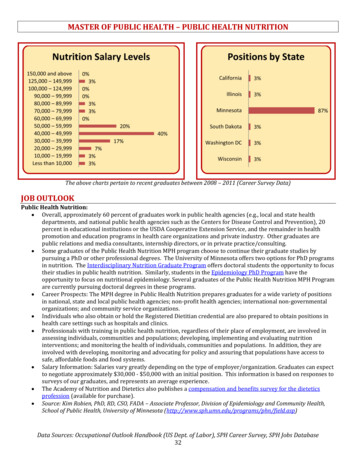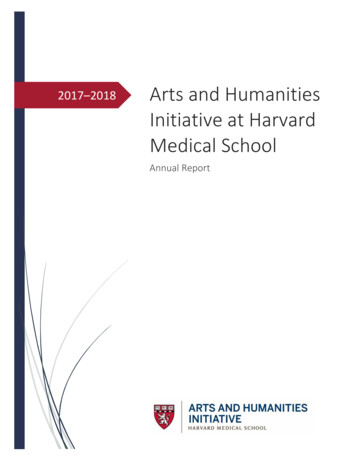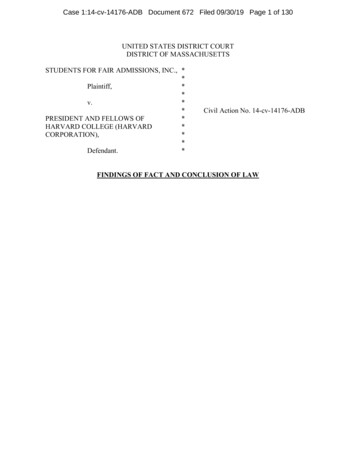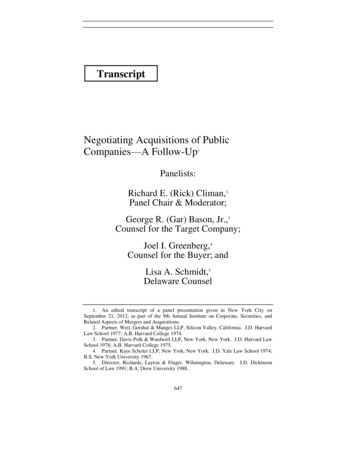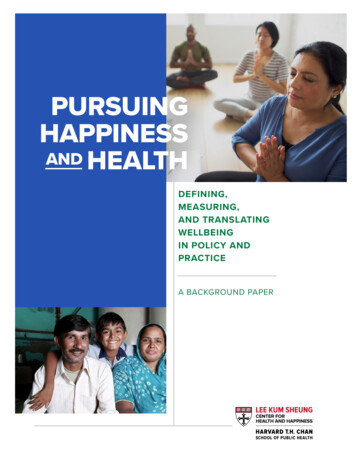
Transcription
PURSUINGHAPPINESSAND HEALTHDEFINING,MEASURING,AND TRANSLATINGWELLBEINGIN POLICY ANDPRACTICEA BACKGROUND PAPER
Background paper prepared by Eric Coles and K. “Vish” Viswanath forLee Kum Sheung Center for Health and Happiness, Harvard T.H. ChanSchool of Public Health. Research support from Jun Nakagawa. Thispaper was prepared for an interdisciplinary workshop, “Health andHappiness in Policy and Practice Across the Globe: The Role of Scienceand Evidence” held in April 2019 (please visit the Center website listedbelow for more information).About the Lee Kum Sheung Center for Health and HappinessThe mission of the Center is to build a rigorous and interdisciplinaryscience of positive health and well-being, and to translate the science toinfluence practice and policy. We aim to achieve this through knowledgeproduction, capacity building, and translation and communication.Funded through the initiative and generosity of the Lee Kum Kee familyof Hong Kong, the Center represents a unique opportunity to advancescientific understanding of the connections between positive psychologicalwell-being, positive social environments, and physical health.Lee Kum Sheung Center for Health and Happiness Co-Directors:Laura Kubzansky, PhDLee Kum Kee Professor of Social and Behavioral SciencesHarvard T.H. Chan School of Public HealthKasisomayajula “Vish” Viswanath, PhDLee Kum Kee Professor of Health CommunicationHarvard T.H. Chan School of Public HealthFor information about the authors and the Center, please contactCenter Administrator Jaime Mchunu, MA, at jmchunu@hsph.harvard.eduor visit https://www.hsph.harvard.edu/health-happiness.
INTRODUCTIONhe promotion of “happiness” is generating considerable buzz amongpolicymakers, academics, governments, and, of course, the general public.The idea is central to a growing social movement that is calling on governmentsto measure and consider happiness in policy decisions. However, the intention topromote happiness, or wellbeing, has a long and prestigious history, having been asubject of attention in religious philosophies of both the East and the West. Whilemany are trying to use public policy to increase happiness or other variants withwhich it is conflated, such as “wellbeing,” or “life satisfaction,” many questionsremain. What are the policies, if any, that governments should adopt to promotehappiness? To what extent can happiness be promoted through governmentpolicies and practices? How is happiness related to other realms of public andprivate life—specifically, health?While a variety of organizations, major international bodies, and several governments have undertaken laudable actions to increase happiness, these questions remainunanswered because of two major gaps in translating research into policy, which mustbe addressed if the movement to promote happiness is to advance. The first is clarityon the concept of happiness, especially how it is defined, measured, and to what end.A review of a subset of the reports and projects note a variety of terms used to describewhat they are measuring—”happiness,” “wellbeing,” “flourishing,” and “quality of life,”among others. The abundance of terms plausibly underscores deeper differences inphilosophies and practices, making it difficult to track across time and space. Absent aconsensus on a definition and purpose, it is questionable as to how to develop, execute,and track the impact of public policies to promote happiness.3
The second challenge is the inconsistent understanding of the role of health inhappiness/wellbeing policies and practices. Again, a review of a subset of happinesspolicies from around the world finds that health is defined in terms of physical,mental, or psychological dimensions and is included in measures as a constituentpart, as another discrete concept, or as the total concept of happiness itself. Forexample, the World Happiness Report,1 one of the more prominent and systematicinternational efforts supported by the United Nations, equates happiness withwellbeing and measures the value by a subjective question about life satisfactionfrom the Gallup World Poll. The Organization for Economic Cooperation andDevelopment (OECD) Better Life Index, another international measure, includesboth wellbeing and physical health as distinct components within a framework tomeasure social progress.2 Bhutan’s Gross National Happiness Index (GNHI) purportsthat happiness is their overall measure, which includes physical health and mentalhealth as two of nine components of happiness.3On the other hand, the World Health Organization (WHO) defines health as“. a state of complete physical, mental and social well-being and not merely theabsence of disease or infirmity.” 4 Considering that health consists of states ofwellbeing, then the two terms may appear to be equivalent. However, the WHOdoes not equate either with happiness. Thelesser-known sentence before the definitionstates that health is one of the basic principles for the “ happiness, harmonious relations and security of all peoples” 4 (emphasisadded). Despite some criticism, the WHOdefinition is still the seminal description inthe field. How we reconcile the relationship between health, happiness, and wellbeing is more than a pedantic issue. Healthcare is one of the largest industries inthe world. If happiness was in the purview of health, then happiness policies wouldhave access to many more resources than it has now. If health is a component ofhappiness, then the health sector needs better coordination with other sectors thatimprove happiness.The goal of this background paper is to review:A growing social movement is callingon governments to measure andconsider happiness in policy decisions. Major definitions of happiness that have been developed and measured How health is connected or not connected to happiness The gap between research, practice, and policy in connection with happinessand health.The goal of this background paper is not to offer an extensive review of theseissues—in fact, our review is selective—but to serve as a background document fora more systematic exploration to build a bridge between policies and practices topromote wellbeing and research on wellbeing in all its variants.4
BACKGROUNDBRIEF HISTORYany current discussions about happiness policies compare wellbeingmeasures with Gross Domestic Product (GDP), which is arguablythe prevailing indicator of growth and development. Because GDP is oftenthe comparator, it is important to understand the history of its development.The history of GDP begins in the 1930s, when the US government sought tounderstand the degree of economic instability and disruption caused by theGreat Depression. A committee within the US Congress chose Simon Kuznets, aneconomics professor at the University of Pennsylvania at the time, to examine theproblem of economic measurement. Kuznets’ solution was a method to aggregateincome of individuals and businesses across the nation, which developed into theapproach to GDP we still use today.5Though his measure caught on, Kuznets was quick to criticize it, warningof its limitations, especially around inequality. GDP does not track inequalitywithin a country—a prescient observation for the current time.5 It also does notadequately account for unpaid labor, such as family childcare, and consumptionexternalities, such as pollution and environmental damage. Despite his warnings,seeking GDP growth became conventional government wisdom as a way toindicate that lives were getting better, though criticism dogged the conceptthroughout the 20th century.6 One famous example, at least in the West, wasa 1968 observation from then Presidential candidate Robert F. Kennedy: “[GDP]measures everything in short, except that which makes life worthwhile.”7It is this idea of what is “worthwhile” that drove some across the globe to lookbeyond GDP and measure social progress in other ways, especially the small Asian5
country of Bhutan. Per an apocryphal story,8 Bhutan’snovel vision of development was started by an offhandstatement by King Jigme Singye Wangchuck, in 1979,in the Mumbai, India, airport. He said in reply to aquestion from a journalist, “Gross National Happiness(GNH) is more important than Gross DomesticProduct.”There is no published, contemporaneous mentionof this incident. The first published piece to mentionGNH was an article in London’s Financial Timesby journalist John Elliot in 1987,9 who traveled toBhutan to interview the king. The idea had minorand sporadic references in the early 1990s until theBhutanese prime minister discussed the idea in a1998 speech at the Asia-Pacific Millennium Summitin Seoul, Korea.10 In the years following this speech,Bhutan facilitated five international conferenceson using happiness as an explicit development goalbetween 2004 and 2009.10Another alternative approach to GDP was theHuman Development Index (HDI), which was first developed in 1990 by theeconomists Mahbub Ul Haq and Amartya Sen. The goal of the HDI was tomeasure the “richness in human life,” rather than a country’s income.11 Ul Haqand Sen were attempting to create a broader measure of development to betterencapsulate quality of life, though they did not include a measure of happiness.Instead, the three dimensions of HDI are physical health, as measured by lifeexpectancy, knowledge, as measured by years in school, and standard of living, asmeasured by Gross National Income per capita. The HDI is also published withadjustments made for gender justice and socio-economic inequality, to highlightspecific development issues.11In 2008, then President of France, Nicholas Sarkozy, took a major step topromote alternative measures to GDP. Dissatisfied with the economic and socialmeasures his government was using, he formed a commission headed by Frenchacademic Jean-Paul Fitoussi with Nobel Prize-winning economists, Amartya Senof the HDI and Joseph Stiglitz, to study the limitations of GDP and recommendimprovements to measures of social progress. The commission worked during aninteresting time. It was formed before the 2008 global financial crisis but gaveits final report afterward, noting in it that the time appeared prescient for majorchanges.12The Commission released the Report by the Commission on the Measurement ofEconomic Performance and Social Progress, also known as the Stiglitz-Sen-Fitoussi6
Report. Its key message was a recommendation for governments to “shiftemphasis from measuring economic production to measuring people’s well-being”(p.12).12 GDP was still seen as a useful measure, but the authors suggested thatconsiderations of wellbeing were needed as a supplemental measure to address theincreasing gap between aggregate GDP and what cultivated individual wellbeing.The report offered recommendations on measurement and described eightsubcomponents of wellbeing, including wealth, health, education, and subjectivesatisfaction measures.U N ITE D N ATI O N S’ I N VO LV E M E NTOverall, the Stiglitz-Sen-Fitoussi Report drew new attention to the idea ofmeasuring wellbeing, but created little immediate change, possibly due to thefinancial crisis. Bhutan, however, continued to advocate on the international stageand sponsored a resolution at the United Nations in July 2011.13 The resolutionraised many of the same issues as the Stiglitz-Sen-Fitoussi Report, such as thelimitations of GDP, stating that it does not adequately reflect the wellbeingand happiness of citizens. It also invited countries “to pursue the elaboration ofadditional measures that better capture the importance of the pursuit of happinessand wellbeing in development with a view to guiding their public policies,” andstated that “the pursuit of happiness is afundamental human goal.”14This resolution included a call for ahigh-level meeting to occur the followingyear. In 2012, that meeting took place inNew York, led by Bhutan, and includeddiscussion of a new economic paradigmto analyze society and development.13 Theconversation came at a fortuitous time asthe UN was planning the 2015 SustainableDevelopment Goals (SDG) and how theywould be evaluated. Measuring happiness, or wellbeing, was discussed as an optionfor evaluating efforts toward the SDG goals, but no major action was taken.13However, a major milestone of the meeting was the first publication of theWorld Happiness Report 2012, which was led by three academics: John Helliwell,professor emeritus of economics at the University of British Columbia, RichardLayard, director of the Centre for Economic Performance at the London Schoolof Economics, and Jeffrey Sachs, director of the Earth Institute at ColumbiaUniversity.15 Their report had three major sections. The first section arguedfor the importance and validity of measuring happiness and highlighted threeongoing efforts: the Gallup World Poll, the World Values Survey, and the EuropeanThe key message of the Stiglitz-SenFitoussi Report was a recommendationfor governments to “shift emphasisfrom measuring economic productionto measuring people’s well-being.”7
Social Survey. The second section considered what factors influence happiness,such as mental and physical health, family, and education. The third sectionlooked at the policy implications of measuring happiness. Objectives of policieswere considered, such as increasing employment to improve wellbeing, and itended with case studies on efforts in the UK, the OECD, and Bhutan.15Since the 2012 inaugural report, the World Happiness Report has been publishedannually, independent of the UN, but with financial support from the SustainableDevelopment Solutions Network, a UN affiliate. All reports have included a rankingof the “happiest” countries from around the world, with data based on the GallupWorld Poll.1 In 2019, the rankings were based on pooled results (2016-2018) ofresponses to a single survey question in the Gallup World Poll:Please imagine a ladder, with steps numbered from 0 at the bottom to 10 at the top. Thetop of the ladder represents the best possible life for you and the bottom of the ladderrepresents the worst possible life for you. On which step of the ladder would you say youpersonally feel you stand at this time? 16A country’s score was created by weighting results by population andaveraging across the three years. It is worth noting here that it is critical toexamine the extent to which the previous question’s wording measures happiness,say, using a ladder, and whether it is applicable across different countries andcultures, considering issues of measurement validity and reliability.In addition to the aggregate scores,the 2019 report looked at global trends ofhappiness from the inception of the GallupWorld Poll in 2005 to 2018. Measures includednot only the previously referenced Cantrilladder, but positive and negative affect. Forpositive affect, people answered “yes” or“no” to the question of whether they hadhappiness, laughter, or enjoyment on theprevious day. Negative affect was measuredby those who had worry, sadness, or angerthe previous day. Since these questions werebinary (yes or no), their average indicatesthe prevalent percentage of affect in the population. The report also includes achapter describing the relationship between happiness and political behavior,such as voting. Most often political behavior is seen as the cause of happiness.However, there is an emerging field of study that questions the direction of thisrelationship and uses happiness to explain political behavior. This promising fieldmay entice politicians to consider happiness more, since initial results suggesthappier societies are more likely to re-elect politicians.In 2018, for the first time, therewas a corollary report to theWorld Happiness Report, calledthe Global Happiness Policy Report,which was a targeted look at publicpolicies that promote happiness.8
G LO BA L H A PPI N E SS P O LI CY R E P O RTSIn 2018, for the first time, there was a corollary report to the World HappinessReport, called the Global Happiness Policy Report, which was a targeted look at publicpolicies that promote happiness.17 The report was produced in conjunction withthe World Government Summit in the United Arab Emirates (UAE) in February2018 and was written by the Global Happiness Council (GHC), which includedeconomist Jeffery Sachs, psychologists Martin Seligman and Ed Diener, andMartine Durand, the chief statistician at the OECD. The GHC was formed in 2017mainly from the authors who wrotethe World Happiness Reports tofacilitate adoption of happinesspolicies in interested countries. Thesecond annual report was publishedin February 2019.The objective of the 2018report was to inventory andassess policies and practices toeventually identify best practices.The 2019 report aimed to identifypolicy frameworks and specificinterventions that would increasehappiness. The first step in theprocess was to identify policythemes. Six were chosen: health,education, work, personal happiness,cities, and metrics (p.13).17 Theauthors write: “The chapters generally accept as a starting point that subjectivewell-being—especially, but not exclusively, assessed by asking how people evaluatethe quality of their own lives—provides a good measure of the quality of lifein society as a whole, and is a useful focus for public policy.” The authors foundseveral common themes in policies: a gap between the scope of data collected andwhat data are needed to design and select policies, a need for more deliberativeexperimental approaches to identify best practices, greater input of internalstakeholders, difficulty in forming generalizations due to local contexts, and thevalue of interventions on children, now and for the future. It was also noted thatthe current measures of happiness are on the periphery of policy making, ratherthan the central evaluative metric, where the authors want them.The 2018 report ended with an appendix that included a list of policy ideas fromeach of the six themes. The goals of these policies are either to increase happinessor to reduce misery. The list included nearly 100 ideas, categorized as principles,9
interventions, and public/private initiatives. They can roughly be split into bestpractices for cities or for nations. The best practices at the national level are: Regular measurement of wellbeing Rigorous evaluation of interventions Expanding the evidence base on work and wellbeing Ex post and ex ante subjective well-being (SWB) monitoring of policies Charging national statistical offices with the development and collection ofdata on subjective wellbeing Aiming for international comparabilityA special section looked at happiness specifically in cities, noting that peopleface different challenges, namely the availability, simplicity, and usability ofbasic services in cities (p.161).17 Following the “Smart Cities” framework by theEuropean Union, the recommendations for cities are: Collect citywide happiness measures Make happiness an explicit aim of city government Crowdsource city service quality data Guide and evaluate policy using standardized data-processing approaches Consider trust in the city as a desirable policy outcome Balance the need for evidence with the imperative of innovationThe 2019 report focused on similar policy areas but focused on frameworksfor policy making.18 They gave eight recommendations for supporting successfulhappiness policies:1. Establish happiness strategies2. Create the “magic sauce” to turn talk into action, translating research intopolicy and practice3. Enable collaboration within ministries or organizations4. Enable collaboration across ministries, NGOs, and others5. Create the necessary space for experimentation, innovation, evaluation, andrisk-taking6. Facilitate consistency among policy choices7. Assure continuity8. Learn from experiences near and farIn addition, the 2019 report devoted an entire chapter for using happinessmeasures to appraise healthcare priority setting. The authors note that healthspending is around 10% of global GDP and national health outcomes areinconsistent with overall spending. Thus, how resources are allocated is vital tohealth outcome. They argue that happiness measures should be used to appraise10
resource allocation and offered the following four recommendations. Formalhealthcare appraisal should: guide decision making, consider opportunity cost,measure benefits in terms of happiness rather than health, and include benefits toall parties, not just patients.Finally, the World Happiness Report 2019 made five recommendations to centralgovernments on where to introduce happiness policies: in the budget process, inlegislation to establish wellbeing objectives or collect wellbeing data, in nationaldevelopment strategies with a wellbeing focus, in new ministries or agencies, andin strengthening civil service capacity.18E F FO RTS OUTS I D E G OV E R N M E NTComplementing the work by Bhutan and the Global Happiness Council, severalcivil society organizations and for-profit companies are also advocating forwellbeing measures and policies, such as the New Economics Foundation,Happiness Alliance, Oxford Foundation for Knowledge Exchange, Action forHappiness, Gross National Happiness USA, Greater Good Science Center, theBoston Consulting Group (BCG), and What Works Centre for Wellbeing, amongothers. Most of these organizations are based in the UK, and many producereports and rankings of happiness countries.A select few are highlighted below.The New Economics Foundation is a UKthink tank that seeks to empower peopleto take greater control of the economy. TheFoundation published the Happy Planet Indexin 2016 to measure sustainable, communitywellbeing,19 which they calculated bymultiplying three components—wellbeing(according to the Gallup World Poll), lifeexpectancy, and inequality as measured bythe GINI coefficient—and dividing by theirenvironmental impact.—Global Happiness Policy Report 2019The Oxford Foundation for KnowledgeExchange published the Global Analysis of Wellbeing Report.20 Their report includespolicy recommendations for civil organizations, in addition to recommendationsfor government to increase wellbeing. In addition to policy recommendations,their report has seven suggestions for measuring wellbeing, including measuringmultiple domains, measuring across the life-course, and using subjective measures.The report also includes nine case studies.The What Works Centre for Wellbeing is a non-profit consulting firm in theUK that offers help to small and medium-size organizations to start measuringFormal healthcare appraisal should:guide decision making, consideropportunity cost, measure benefitsin terms of happiness rather thanhealth, and include benefits to allparties, not just patients.11
and impacting the wellbeing of stakeholders. They offer nine steps to aid organizations in identifying subjective and objective measures, in choosing questionsto ask about the measures, in running analyses on the results, and then in usingthe data in future decision-making.21 They work with researchers, think tanks,businesses, government departments, and non-profits on several attributes ofwellbeing, such as housing, workplace wellbeing, and physical activity.Moreover, some for-profit companies have gotten involved. The Boston Consulting Group (BCG) publishes a Sustainable Economic Development Assessment (SEDA),which measures the sustainability of a country’s development.22 Sustainability isdefined as both environmental and social inclusion, which includes governance andcivil society. SEDA uses 40 objective indicators, including health, to rank countriesand help governments identify needs and priorities of their citizens.R E P O RT’ S R A N K I N GSSeveral of the reports mentioned above rank countries. A summation of selectrankings by different organizations is reported in Table 1. There is clearly ahigh representation of Scandinavian countries, which take up some or all toppositions in the World Happiness Report, HDI, SEDA, and OECD Better Life. Thebiggest outlier is the Happy Planet Index, because their formula accountsfor environmental impact, and the per capita impact for Central and SouthAmerican countries is much lower than others. One caveat for true comparisonacross rankings is the number of countries included in the measures: The WorldHappiness Report and the HDI measure over 180 countries, SEDA includes 152countries, Happy Planet includes 140, and Better Life includes 38—the OECDcountries, plus Russia and Brazil.Table 1. Cross-Country RankingsInternationalcomparisonsTop 3 countriesWorldHappinessReport 2019HumanDevelopmentIndex (HDI)BCG’s SEDAHappy PlanetIndexOECD BetterLife*FinlandNorwayNorwayCosta arkNorwayAustraliaIcelandColombiaAustralia*The Better Life Index does not give explicit rankings because dimensions can be weigheddifferently. The top 3 countries are listed if all dimensions are weighted equally.12
DEFINING ANDMEASURING HAPPINESShile the previous section provided a brief review of the current stateof happiness and wellbeing projects, this section will discuss how theconcept of happiness has been defined and measured in academia and in practice.It is notable that the preceding section focused on the field of public policy, whichis led mainly by economists. In this section, we will see how behavioral scientists,primarily psychologists, have led the field in defining happiness and the practicalreplications of these studies. We will provide a brief overview of the concept inacademic research and discuss the definitions and measures used in practice.B R I E F H I STO RY O F H A PPI N E SS I N TH E LITE R ATU R EIn peer-reviewed literature, the terms “happiness,” or “wellbeing,” began to appearin the early decades of the 20th century, according to a literature analysis.23Early published papers examined the concept in married couples and in recentuniversity graduates.24 In a citation review of academic literature, the terms“happiness” and “wellbeing” occurred as early as 1904, but sporadically until1960, when the terms appeared more consistently.23 A cursory review of some ofthe major works in this field include Wilson’s (1967), which looked at factors for“avowed happiness,”25 and Bradburn’s (1969), which was an early examination intothe structures of psychological wellbeing.26 Diener’s work (1984) made importantcontributions toward the definition of “subjective wellbeing,” noting the threehallmarks of the concept: that it is subjective, includes positive measures, and is aglobal assessment of all aspects of one’s life.2713
In addition to these works that defined the concept, there are also some keyworks in exploring its dimensions, especially adding a social element. Ryff (1989) wasnotable for advocating for social factors to be included in psychological wellbeing,bringing in the issue of social context to thepsychological domains.26 The importanceof social aspects in wellbeing was refined inKeyes’ work (1998) around five dimensions: socialintegration, social contribution, social coherence,social actualization, and social acceptance.28Table 2 lists some definitions of happiness or avariant from peer-reviewed literature.Another major moment in exploringhappiness and wellbeing came in 1998 withpsychologist Martin Seligman’s speech to theAmerican Psychological Association, when hecalled for a “positive psychology” that wouldreorient the science toward positive qualitiesof an individual.29 He felt that psychology hadbecome too focused on curing mental illness, rather than studying positive traitsof individuals. He echoed the words of Robert Kennedy:Another major moment in exploring thedimensions of happiness and wellbeingcame in 1998 with psychologist MartinSeligman’s speech to the AmericanPsychological Association, when he calledfor a “positive psychology” that wouldreorient the science toward positivequalities of an individual.Yet we have scant knowledge of what makes life worth living. For although psychologyhas come to understand quite a bit about how people survive and endure underconditions of adversity, we know very little about how normal people flourish Positive psychology itself has flourished in the years since his speech. Ongoingresearch has focused on the specific components of what makes a positive life,such as grit, optimism, happiness, and flow. Seligman himself has published manybooks in the field, such as Flourish, Authentic Happiness, Learned Optimism, and mostrecently, The Hope Circuit.30Seligman’s most recent theory offers five building blocks of wellbeing underthe acronym PERMA: Positive emotion, Engagement, Relationships, Meaning, andAccomplishments.30 “Positive emotion” is the hedonic, colloquial idea of feelinghappiness, though it can be extended beyond the present in two ways: into the pastby building gratitude and forgiveness, and into the future by building optimism.“Engagement” references participating in an activity where you “lose yourself” andcreate flow. “Relationships,” another building block, are the social connectionsto others in one’s life. “Meaning,” also sometimes called purpose, is a feeling ofconnection to a higher purpose or calling in life. Finally, “accomplishments” arewhat people pursue because of drive or ambition. Striving toward accomplishmentsis an end in itself to some people, regardless of the outcome.The PERMA theory has been further refined by Tyler VanderWeele, who14
equates human wellbeing with the term“flourishing” and summarizes some ofits major determinants based on empirical research.31 He identifies five majordeterminants of human wellbeing as:happiness and life satisfaction, physicaland mental health, meaning and purpose,character and virtue, and close socialrelationships. He describes how thesedeterminants are impacted along fourpathways: family, work, education, andreligious community. Because there a
Funded through the initiative and generosity of the Lee Kum Kee family . indicate that lives were getting better, though criticism dogged the concept throughout the 20th century.6 . as measured by years in school, and standard of living, as measured by Gross National Income per capita. The HDI is also published with adjustments made for .


